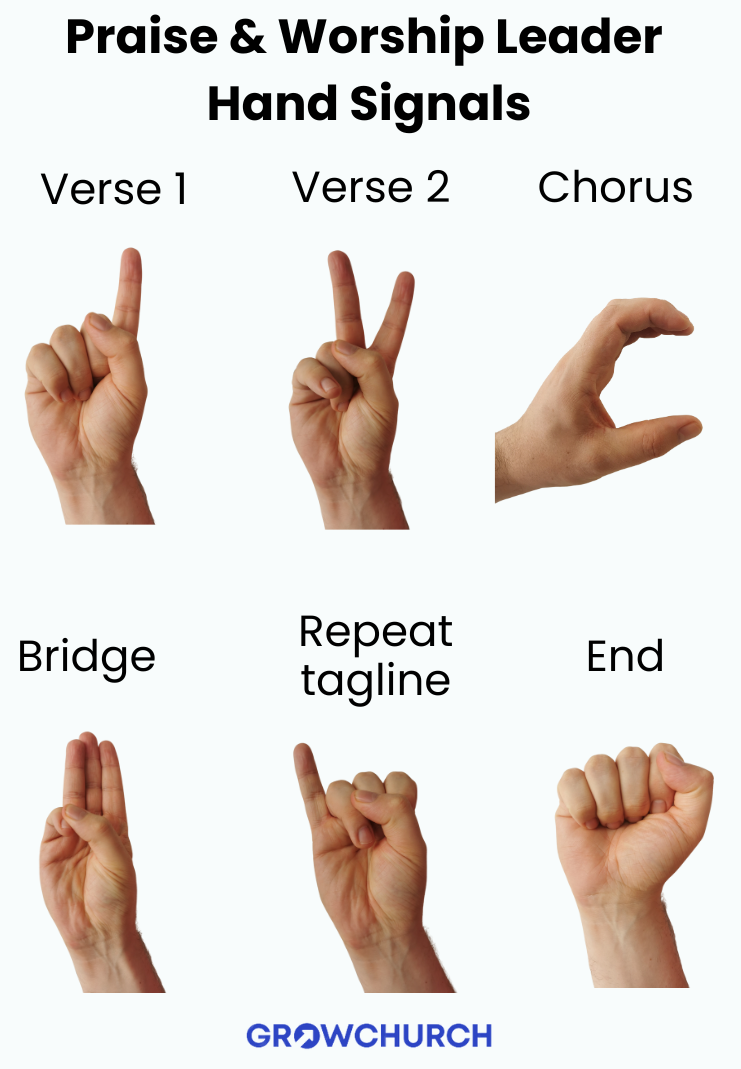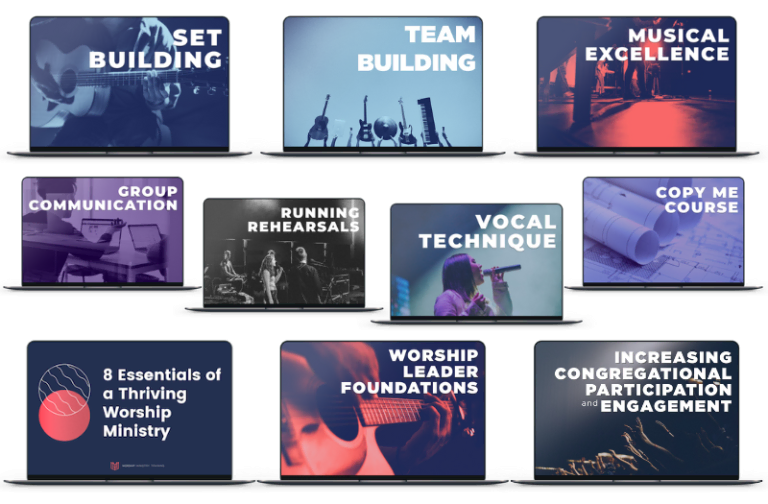Looking for worship leading tips to give yourself the best shot at creating transformative worship experiences?
Whether you’re a beginner or experienced, you want to lead worship well.
It can mean the difference between a service where people connect with God and one that falls flat.
That’s why, instead of overwhelming you with complex theories, I’m going to focus on insanely practical worship leading tips taken from Worship Leader Training and my 15+ years of experience leading worship in churches around the world.
I had to learn most of this stuff the hard way, but thankfully you’re here so you can get a headstart.
Ready?
Let’s dive in!
1. Know What Your Job Is
First things first, let’s nail down what a worship leader is:
A worship leader is one who guides God’s people into worship.
Your role is to facilitate God encounters.
Think about it this way:
Your congregation’s week could’ve been a chaotic roller coaster…
Some might’ve had to navigate the stress of a demanding job…
Others might’ve faced personal storms that shook them to their core.
They all come seeking that connection with God’s presence.
Your mission?
To create an atmosphere where hearts can respond to His greatness, minds can lay down their burdens and find peace in His faithfulness.
So, as you stand before them next Sunday, remember that you’re more than a musician or a singer of songs – you’re a bridge builder between God and His people.
2. Get The Best Worship Leader Training
No matter the size of your congregation, the pursuit of excellence never stops.
Whether you’re leading a bustling megachurch or a close-knit community, the path to becoming the best worship leader you can be means you’re constantly learning and developing your skills.
Enter Worship Ministry Training, the best worship team training with over 15 in-depth courses and a community of 10,000+ fellow worship leaders all helping each other elevate their worship game.
Watch this video for more info:
3. Lead With Unshakeable Confidence
Let’s face it, this is easier said than done!
As you’re leading worship on a Sunday, you’ll have some people who are fully engaged, arms lifted high soaking in the presence of God.
Then you’ll have others there with their arms crossed giving you the death stare.
In my early days, I led worship at a church where two elderly ladies would stand on the front row with fingers firmly planted in their ears – a visual protest against the music’s volume.

And guess what?
That lasted a whole three months.
True story! 😂
I sincerely hope this never happens to you (it’s offputting, to say the least!)
But even if it does, keep your confidence unwavering. Don’t let stern expressions, technical hiccups or any other curveballs throw you off.
The secret to confidence is practising well with your team.
That and focusing on those who are fully engaged. Do it for them.
Oh, and passion – it’s your secret weapon. Embrace it, exude it and watch it sweep through the room.
Passion is contagious and, before you know it, even the sceptics might just tap their toes.
4. Don’t Wreak Havoc With Too Many New Songs
Picture this:
You’re leading worship, the Holy Spirit’s presence is tangible and everyone is really pressing in.
Then you start a brand new song, everyone disengages and you’re looking at a wall of blank stares.
You want to introduce new songs strategically to try and avoid this from happening. As a rule of thumb, I’d say introduce a new song every 4 weeks.
The first time you play it could be during the offering. This initial exposure gives the congregation a chance to familiarise themselves with it.
Then you could sing the song consistently over the following 2 to 4 weeks until it’s everyone’s new favourite.
5. Pick Singable Songs
Being a worship leader can feel like an impossible juggling act because you’re expected to lead 16-year-olds and 86-year-olds in worship at the same time.
The youth crave the latest hits and the seasoned saints just want to go back and sing the old hymns…
It’s like trying to DJ a party where the guests want everything from Bach to Bieber.
Music style and personal taste is such a subjective thing, and you’ll never keep everyone happy all of the time, what I like to do is mix it up a bit between the old and the new.
Go ahead and sing Elevation’s “Jireh” but throw in the occasional chorus of “I exalt Thee” at the end.
And sing songs in singable keys.
The key of G is generally best for men and the key of C or D is easiest for women to sing.
Just something to keep in mind if you want to avoid Aunt May screeching like a drowning cat in the back row! 🐈
6. Harmonise Worship With The Message
Whilst we’re on the topic of choosing songs, here’s a pro tip:
Sync up your setlist with the current sermon series, or find out what the pastor is preaching about next week and find songs that match the theme.
That way, the worship supports the main message.
Say the sermon’s all about God’s unwavering love. You could sing:
If the sermon is about overcoming challenges and finding strength in adversity, you could choose worship songs that echo themes of victory like:
By weaving your song choices into the fabric of the sermon, you’re creating a powerful unity that deepens the impact of both the worship and the teaching.
7. Know Your Purpose
Are you leading worship at your home church on a Sunday, visiting another church, leading worship at a conference, in a prison or at a wedding?
What’s the goal?
Is it a time for powerful praise that gets people fired up?
Is it a moment for intimate worship and drawing closer to Jesus?
Every setting has its own distinct expectations. Understanding these nuances will shape your song choices, your leadership approach, and the duration of your worship.
The legendary Don Moen puts it much better than I can so I’ll hand it over to him…
8. Intentionally Craft Your Setlist
Leading worship isn’t merely selecting songs at random; it’s creating a captivating journey for your congregation.
Think of it as crafting a story, where each song is a chapter guiding emotions and thoughts.
Your setlist serves as the compass, dictating the pace, mood and ambience of various moments throughout the worship service.
It conjures emotions, ranging from deep reflection to joyous celebration, carrying the congregation on a spiritual voyage that resonates long after the music fades.
You could start with a song that ushers in God’s presence, then transition to praise songs that escalate the energy, culminating in a powerful worship anthem.
Or you could start the service on a high with a fast-paced praise song to get everyone engaged and gradually turn down the tempo ending with an intimate worship song that prepares people’s hearts for ministry.
Experiment with different setlist configurations, adapting them to the purpose you’ve identified in tip #7.
9. Work On Your Transitions
Smooth transitions are the secret sauce of a seamless worship experience.
When moving from song to song, you want to keep the momentum going and maintain that powerful connection with the congregation.
Opt for songs with matching keys. This not only creates a harmonious transition but also prevents jarring shifts that could disrupt the worship flow.
I like to use the keyboard to fill the gaps. A well-placed chord progression can bridge songs and avoid any awkward dead air.
10. Lose The Music Stands
This seems such a small and insignificant thing that I almost didn’t include it…
But trust me, ditching those music stands will make such a difference.
I get it – hiding behind the music stands feels safer, like a cosy security blanket that shields you from the spotlight and the potential slip-ups that come with it.
Yet, imagine the freedom of leading without them.

And if you’re worried about forgetting the next verse or chord sequence, consider having a monitor set up on stage at your feet or discreetly placed on the back wall of the sanctuary.
By doing so, you’re free to connect with the congregation and guide them through worship without any barriers in your way.
So, give those music stands a break and step into the spotlight of genuine connection.
11. Master The Inbetweeny Moments
Worship isn’t just about the songs; it’s about the entire experience you create – and that includes those in-between moments when you’re not singing your heart out.
Before you lead worship, decide what bible verses you’re going to share.
Plan what you’re going to say before worship, after worship, and between songs.
I can’t tell you how many times I’ll start ad-libbing, only to lose track or veer off into random tangents.
That’s why it’s also essential to rehearse your ad-lib moments beforehand. Trust me, practising those unplanned but oh-so-important interactions can turn into memorable moments that engage, inspire and keep everyone engaged.
So, whether it’s reading a scripture, offering a heartfelt prayer, sharing a personal insight, or simply encouraging the congregation to lean in, plan your in-betweeny parts well.
They can be just as powerful as the songs themselves.
12. Trim Your Repertoire Regularly
Having an extensive library of songs might seem impressive, but in reality, it can lead to a whole lot of chaos for you, your worship team and even the poor soul handling the PowerPoint slides.
Think about it:
With thousands of songs at your disposal, how do you decide what to play?
How do you ensure that everyone is on the same page?
And heaven forbid, if you decide on a last-minute change, it’s like trying to orchestrate a musical hurricane.
So, here’s a piece of advice:
Keep it simple.
Rather than drowning in a sea of endless choices, curate a streamlined repertoire of no more than 50 songs. These are your tried-and-true, crowd-pleasing gems everybody knows and loves.
This not only makes things easier for everyone but also helps your congregation feel more connected and familiar with the songs.
13. Lead Your Team
As a worship leader, you have two jobs:
- Lead the congregation
- Lead your worship band
And there’s a delicate balance between leading by example by being a worshipper and leading your worship team.
You don’t want to get so lost in worship with your eyes closed, hands in the air, completely oblivious to everyone around you with your team having no clue where you’re going next.
The solution?
Clear communication.
Maintain eye contact, give nods or even use those infamous worship leader hand signals.
It’s like speaking a secret musical language that ensures everyone’s in sync and on the same page.

14. Read The Room
Master the art of reading the room – it’s your backstage pass to adjusting on the fly.
Keep a watchful eye on your congregation and you’ll soon develop an instinct for when they’re leaning in or zoning out.
Don’t forget to also stay tuned in to the pastor or MC (or whoever’s steering the ship).
They might throw you a curveball, like sharing a word or signalling for a chorus encore.
Leading your team, scanning the congregation, checking in with the pastor and keeping an open ear to the Holy Spirit might sound like a tall order – and it is – but it’s a bit like learning to drive. With practice, it’ll become second nature.
15. Don’t Be Afraid To Make Team Changes
As worship team leader, you’ll have to deal with 3 types of people:
- Those who are willing and competent
- Those who are willing and incompetent but trainable
- Those who are willing, incompetent and untrainable
It might feel harsh but sometimes you need to protect the intemusical integrity of your team.
While Psalm 100:1 encourages “a joyful noise”, Psalm 33:3 reminds us to “Sing to Him a new song; play skillfully with a shout of joy.
Balancing these verses can sometimes mean making tough decisions to protect the integrity of your team.
Imagine you’ve got a vocalist who’s always singing off-key no matter how much worship training she’s gone through. It might be best for her (and everyone else) if she served elsewhere.
Maybe she’d shine in the church’s welcome team or be better suited to Kids Church.
Additionally, don’t hesitate to audition new potential team members. In fact, I’d highly recommend it.
Passion is great and all and we’re not expecting perfection, but some people just don’t have any musical ability whatsoever and you need to lead with excellence.
16. Invest In & Elevate Your Team
Equip them to become the best drummers, guitarists, bass players, keyboardists or singers they can be.
Remember, 2 Timothy 1:6 urges us to “Stir up the gift of God which is in you.”
Investing in their training not only enhances their skills but also elevates the overall worship experience of the church – it’s a total win-win.
WorshipLeaderTraining.com is an exceptional resource that offers a wealth of knowledge and practical tools to empower your team’s growth.
They have step-by-step courses on everything from honing vocal techniques and mastering instrumental skills to enhancing stage presence and creating captivating worship experiences:
And beyond skill development, spend quality time with your team.
Do fun stuff together.
Give them opportunities to give creative input.
Raise other worship leaders up.
Let them start by leading worship in small groups.
Or give them a song to lead or create a schedule where everyone takes turns leading.
And say thank you for the time and effort they put in – especially if they’re volunteers.
Here are some cool ideas from Alex at Worship Ministry Training on how you can show your worship team just how much you appreciate them:
17. Practise Free Worship
Think of your worship team rehearsals not just as technical run-throughs, but as opportunities to connect deeply with God as a team and dedicate time to free and spontaneous worship.
Your worship team is like a musical family and the more you gel together, the more impactful your worship can become.
Through free worship, we learn to build a song from the ground up, letting it rise to powerful crescendos and then gently bringing it back down.
These sessions are about more than just getting better at flowing together as a team; they’re about learning how to follow the Holy Spirit’s leading.
As your team becomes more comfortable with spontaneous worship during rehearsals, consider incorporating it into your actual worship services.
This doesn’t mean throwing your planned setlist out the window, but rather allowing space within the service for moments of unscripted worship.
18. Get A Good Sound Guy
Or train one up.
They’re worth their weight in gold and can make or break the entire worship experience.

You don’t need a ton of expensive equipment to sound good.
What matters most is having someone capable who understands how to set the right volume levels, balance vocals and instruments and create a sonic environment that enhances the worship atmosphere.
Whether your worship space is grand or intimate, having a good sound guy (or gal) can be the difference between a distracting audio mishap and a seamless, immersive worship encounter.
So, consider adding a capable sound engineer to your team or providing training to empower someone to take on this vital role.
Your congregation’s ears will thank you!
19. Nail Your Look
I know, I know, it might seem like a no-brainer, but I’ve witnessed more wardrobe whoopsies in my time than I care to admit.
Different churches have different vibes, right?
Some places are all about jeans and tees, while others give side-eye to anything less formal than a tuxedo.
Wear whatever works in your local setting, just keep modesty in mind…
Picture this – you’re lost in worship with arms raised high when suddenly, people focusing on the Creator of the universe get distracted by you flashing your belly button.
Let’s just try to keep the spotlight on the Almighty and not let your belly button steal the show, alright?
At the end of the day, we’re here to lift hearts, not raise eyebrows.
Enough said! 😂
20. Always Start On Time
The worship band is all set, instruments tuned and hearts ready to lead the congregation into a powerful worship experience.
But as you look out, you notice some familiar faces are missing from the seats – the congregation is late.
In a close-knit church like the one I led worship in early in my journey, even one family’s tardiness could create a noticeable gap in the atmosphere we were trying to create.
Our 10:30 start time often ended up pushed to 10:40 or even 10:45 due to latecomers.
And the problem was that by accommodating tardiness, we inadvertently encouraged more of it. The cycle had to be broken.
My advice?
Pay respect to those who show up on time and start when you’re supposed to. People will quickly learn you’re not going to wait around for them and make the extra effort.
To add a touch of anticipation, consider displaying a 5-minute countdown timer on the screen. It not only signals the imminent start but also builds excitement and keeps everyone informed.
And talking about being on time, respect the authority of the pastor and other church leaders by sticking to the allotted time limits.
When your pastor designates, let’s say 30 minutes, to worship – stick to it and avoid the temptation to stretch it out to 40 or 45 minutes.
21. Record Yourself & Watch It Back
Cringe I know, but trust me, recording your worship sessions can be a game-changer for both you and your team.
If your church is already streaming services online, you’re all set! If not, no worries – just grab your phone, set it up at the back of the church, and hit that record button.
After the service, gather your team for a quick debrief. Watch the recording together and openly talk about what went well and what could be improved.
As you review the recording, pay attention to the dynamics of the worship set.
How did the congregation respond during different songs?
Were there moments that brought a sense of unity or powerful encounters with God?
Sure, it might feel a tad awkward watching yourself on screen, but this is a powerful way to improve yourself, develop your team and together, craft a worship experience that resonates deeply, uplifts spirits and glorifies God.
22. Be A Worshipper First
And now, for the grand finale: the #1 quality of a great worship leader is they are a worshipper first and a worship leader second.
Lead your worship team and congregation not just from a position of skill and expertise, but from a place of deep relationship.
When you’re rooted in that personal connection with God, you’re better equipped to listen, recognise and wholeheartedly follow the Holy Spirit’s leading.
Truth is, ministry life can be all-consuming and it’s easy to get so focused on doing God’s work that we can neglect our own daily moments of connection.
Try following a daily devotional like Satisfy My Soul: A 40-Day Worship Devotional and see how your relationship with God grows.
In the whirlwind of your responsibilities, make sure to carve out time each day to be in His presence. This isn’t just a tip, it’s the heart of effective worship leadership.
So, if there’s a single piece of advice to take away from this entire post, let it be this:
Be a worshipper first.
Everything else will flow from that place of authenticity and devotion.
Elevate Your Worship Ministry Today 🙌

Get 10 step-by-step courses, live monthly workshops and personalised 1-on-1 coaching at Worship Ministry Training.
Join a community of 4,000+ worship leaders who know how to lead with excellence and facilitate life-changing God encounters.
Join Worship Ministry Training »So, Which of These Worship Leading Tips Will You Adopt?
Which tips for leading worship spoke to you the most?
What was your main takeaway and how can you go about applying it to your local church setting?
Let us know in the comments! 👇




